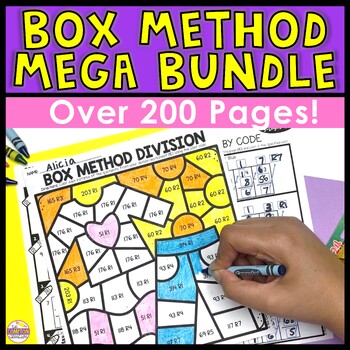Division Box Method Ultimate Activities - 200+ pages of Box Method Division
- Zip
- Google Apps™
- Easel Activity

Products in this Bundle (17)
showing 1-5 of 17 products
Description
You've discovered box method division; now, you need engaging activities for your upper elementary students. Well, this bundle of box method division practice isn't your average! You'll find activities suited for math centers, digital Google Slides, homework, and more.
Please know that you are saving 30% of the individual unit prices by purchasing this bundle.
WHAT IS INCLUDED?
- Box Method Worksheets (3 & 4 Digit Dividends) PDF & Google Slides
- Box Method Worksheets (2 Digit Dividends) PDF & Google Slides
- Box Method Worksheets with Jokes (3 & 4 Digit Dividends) PDF
- Box Method Worksheets with Halloween Jokes (2 Digit Dividends) PDF
- Google Slides Box Method Practice (3 Digit Dividends + Remainders)
- Google Slides Box Method Practice (3 Digit Dividends + No Remainders)
- Box Method Division Color by Code | 2-digit Dividends with Remainders
- Box Method Division Color by Code | 2-digit Dividends WITHOUT Remainders
- Box Method Division Color by Code | 2-digit Dividends MIX Remainders
- Box Method Division Color by Code | 3-digit Dividends with Remainders
- Box Method Division Color by Code | 3-digit Dividends WITHOUT Remainders
- Box Method Division Color by Code | 3-digit Dividends MIX Remainders
- Box Method Division Color by Code | 4-digit Dividends with Remainders
- Box Method Division Color by Code | 4-digit Dividends WITHOUT Remainders
- Box Method Division Color by Code | 4-digit Dividends MIX Remainders
- Box Method Worksheet (2-Digit Dividends) PDF
- Answer Keys
HOW TO USE:
- If you need all things box method division AND scaffolding options, this mega bundle is a must!
- All of my box method worksheets and activities are designed to help students gradually understand the box method division process.
- PLEASE NOTE: There is no specified schedule for releasing new resources. As I create the resources, I will always add them to this bundle.
2-digit by 1-digit, 3-digit by 1-digit, AND 4-digit by 1-digit
- There are 3 levels of scaffold included to help students who may be at varying levels of understanding:
- color-coded boxes in columns to guide students in proper number placement (WITH or WITHOUT guiding arrows as well) and subtraction symbols
- all blue boxes to minimally guide students in number placement (WITH or WITHOUT arrows) and subtraction symbols
- no boxes, only subtraction symbols to remind students to 'bring down'
- There are 4 different packs included!! By popular request, I have added a version with ONLY remainders, NO remainders, and another MIX of remainders and no remainders.
- These worksheets can be used for reinforcement, reteaching, homework, or just practice of the box method of long division!
- If you are looking for a fun, motivating worksheet for the box method of long division, you will love the jokes worksheets!
- Help to create student engagement, but make it academically FUN!
- Each worksheet is clearly labeled with its type (3-digits, 4-digits, no remainders, or remainders) in the top right corner.
- FIRST: Students will solve each division problem with the box method organization method already set up for them.
- NEXT: Students will use the letter represented by the quotient to solve the joke!
- LAST: Watch students explode with laughter and enjoy the process of long division using the box method :)
- Use these during centers, as homework, morning work, or even a fun, fast-finisher activity.
Google Slides Box Method Practice
- There are 15 scaffolded and 15 (more) general practice problems using the box method of long division.
- Color-coded boxes AND columns help guide students in proper number placement, subtraction symbols, and arrows. This helps to solidify the box method process.
- SLIDES 1-15: There is a heavy scaffold, including those mentioned above, and a Number Bank. Students will drag the number to the correct box. All numbers are color-coded to correspond to the boxes as well. Each number in the Number Bank will be used only once.
- SLIDES 15-30: You can gradually release the scaffold using the more general problems included. These still include color-coded columns and boxes, as well as subtraction symbols. There are no guiding arrows. Students will type in their answers.
Box Method Division Color by Number
- Students will complete the problems and color the quotients on the coloring page afterward.
- Assign your students a differentiated version of the practice page (all differentiation is DONE FOR YOU!)
- Before they color, they should fold the page in half along the perforated dashes so the brain teaser isn't showing. It is optional but recommended.
- Students must complete the coloring to find the answer to the brain teaser.
- The answer to the brain teaser is hidden very tiny among the coloring and is circled on the answer keys if students have trouble finding it.
***Please view the preview to see if this resource best fits your needs.***
YOU MIGHT ALSO BE INTERESTED IN:
⭐ 3 Digit by 1 Digit Division Using Box Method Division - Digital & PDF Practice
⭐ Box Method Division Color by Number BUNDLE - Self-Checking Math Worksheets
⭐ Box Method Division 3-Digit Dividends Differentiated Practice for Google Slides
Don't forget to follow me here to get exclusive deals on new products!





